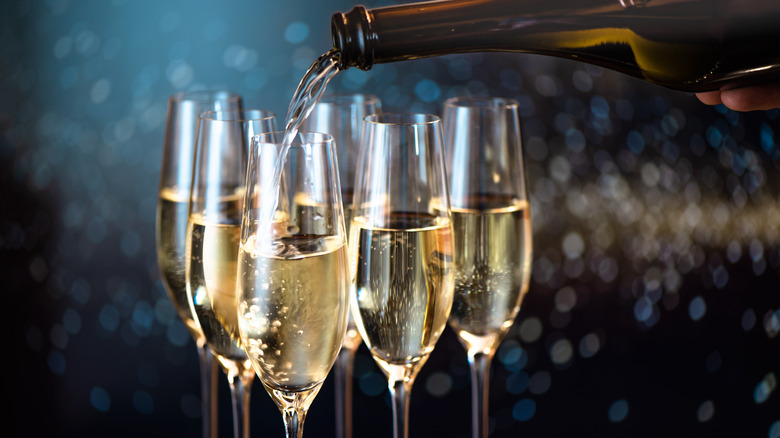Is Champagne Really An Aphrodisiac?
The wine that has launched thousands of ships, Champagne, has a fairly short history as an aphrodisiac. The style of wine now synonymous with celebrations wasn't even developed until the 19th Century. In earlier years, the wines produced in France's Champagne region occasionally had bubbles but those were considered a flaw. Champagne is one of France's coldest regions and cold winter temperatures often halted fermentation. The wines were fermented in the bottle, and in the spring, when fermentation started up again, the gasses that were a byproduct of fermentation would build up in the bottle, making for either a bottle of sparkling wine or a fine mess in the cellar.
So what about the French monk who was supposed to have created Champagne? Well, Dom Perignon was indeed an influential cellar master in the 18th century and is credited with leading the way for modern Champagne production. It is The Dom who was supposedly responsible for the innovation of bottling sparkling wines in heavier glass than that of still wine (to avoid dangerous explosions in the cellar). It is also said that he was instrumental in standardizing the production of what we know today as sparkling wine.
According to The Aphrodisiac Encyclopaedia, the dry style of Champagne we know today was not introduced until the 1840s. Previously, Champagne had been made into a sweet beverage. The dry, Brut style of the mid-1800s took off immediately.
It is unclear when the effervescent drink's reputation as an aphrodisiac took hold. The Aphrodisiac Encyclopaedia claims it is a tie to social status that likely helped elevate the drink, as the wine became "a universal shorthand for success, luxury and social status." It also teases that the ritualistic opening of a Champagne bottle, the release of the cork from the bottle's phallic neck, might have something to do with Champagne's rather notorious role in sexual fantasy.
It is easy to speculate about all the influences on Champagne's sexy reputation (James Bond movies come to mind). Luckily we have the work of modern science to explain the phenomenon in more precise terms.
First of all, let's get out of the way the fact that alcohol lowers inhibition by acting as a sedative on the central nervous system. True, this makes all forms of alcohol aphrodisiac to some degree. But Champagne has one extra property going for it, the "giddy effervescence," as Dr. Allen Green of the Center for Optimum Health in Los Angeles refers to it. Thanks to a series of perhaps not the most precisely administered studies in England, we now know that the alcohol in carbonated drinks is absorbed faster than in still forms of alcohol. This means that not only will sparkling wine get you giddy, but so will a gin and tonic. To precisely what degree is not known; the results seem to have varied. But where all the studies seem to agree is that the giddy effect only seems to last around half an hour. So if you're using Champagne for seduction, you might want to watch the clock.
Many of the health and wellness experts who condone imbibing Champagne — in moderation, of course — appreciate the "giddy effervescence" not for it's ability to lower inhibition but to improve mood and promote relaxation, if only temporarily. Relationship expert Dr. Pepper Schwartz goes so far as to say it will speed up arousal.
Research by Dr. Jeremy Spencer and a team at the University of Reading suggests that up to two glasses of bubbly per day can have heart health benefits like those touted for red wine. The study found that Champagne increases the availability of nitric oxide (which controls blood pressure). But not only does your heart want optimal blood flow, the blood needs to be pumping for sexual excitement.
Serving bubbly may seem like a surefire road to romance. But independent wine director and consultant George Skorka, who has served more bottles of Champagne to happy couples throughout his career than anyone would care to count, offers some expert tips. First, he says, go for rosé, because the rosy hue is almost an aphrodisiac on its own. Then, be sure to serve the wine at an expertly chilled temperature. At approximately 46-48 degrees Fahrenheit, the wine will not only fill the body with its heady effervescence but it will induce the sort of goose bumps that beg for the warmth of an embrace.
As for wines he would serve to someone special, Skorka recommends Perrier-Jouët Belle Epoque Rosé. But if budget is a concern, Skorka is firm in his belief that you cannot go wrong with the Blanc de Noirs Sparkling Wine from American producer Gruet.
Like Skorka, I adore the seductive qualities of a rosé sparkling wine. And as he pointed out, you don't necessarily have to turn to the wines of France's Champagne region to get the benefits of bubbly. Great sparkling wines are made in the Champenoise method around the world. In addition to Gruet, Iron Horse and Schramsberg make world-class bubbles in the U.S. Good value sparkling wines can also be found in France from regions other than Champagne. I recommend Gratien & Meyer N.V. Brut Rosé from the Loire and from Burgundy, JCB No. 69 Rosé.
There are many more great bottles of bubbly in the world to explore. My one suggestion for a successful night of seduction is to check the label carefully. Unless you want your night of passion to come with a grand morning headache, avoid any wine made by the Charmat, or bulk processed method. Stick with méthode Champenoise wines and the pop of your cork will represent total satisfaction.
